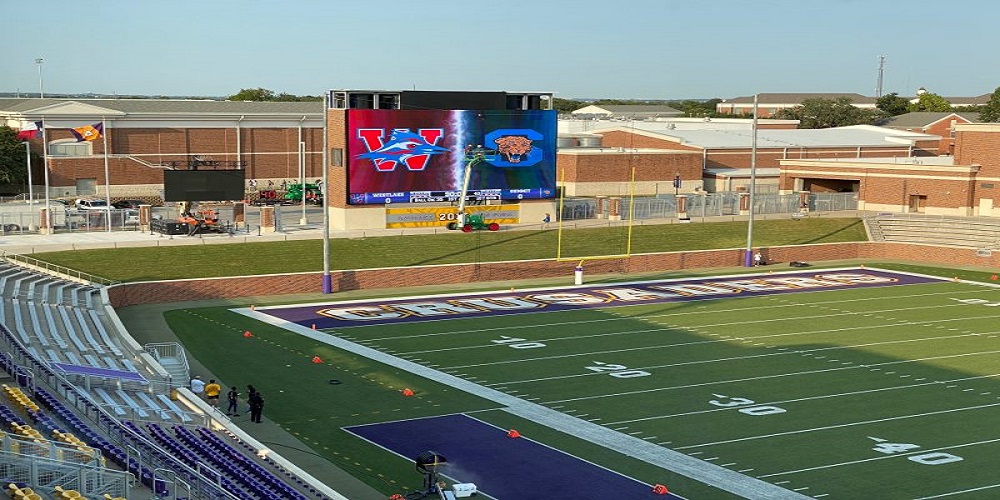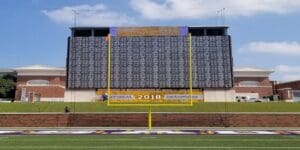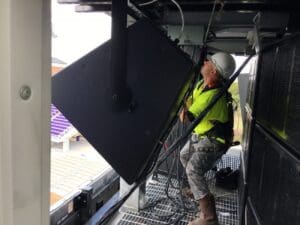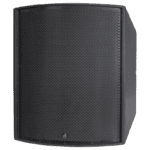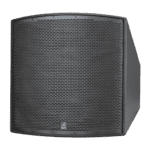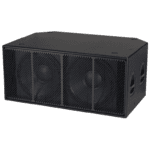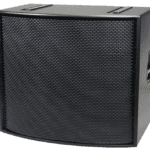Crusader Stadium, the home of the NCAA Cru Football team at the University of Mary Hardin-Baylor, upgraded its end-zone scoreboard and sound system with the help of Daktronics and Fulcrum Acoustic.
According to the university, the goal was to double the size of the video display area while minimizing changes to the existing structure for which it sought the help of Daktronics, the audiovisual solutions provider.
Facing the Challenge
According to the company, since the new, enlarged video display consumed the existing structure’s available space, additional structure was required to house a new sound system. This new structure ended up above the video display, and due to wind loading concerns, it faced a height restriction of 6 feet which further limited the space available for loudspeakers.
According to Fulcrum Acoustic, the end-zone location of the speaker system necessitated a high-output solution to achieve suitable sound levels at the farthest seats. Moreover, strict pattern control was required to keep sound within the seating bowl while also avoiding excessive sound levels on the field and at the seats, and minimizing the sound reflecting off of the Bawcom Student Union building behind the seats on the east side of the stadium.
Daktronics stated that it designed and installed Fulcrum Acoustic speakers to address all the above issues and implement an effective sound system for the stadium.
Installing the Fulcrum Acoustic Speakers
For long-throw coverage, Daktronics says that it deployed six Fulcrum Acoustic AHS speaker modules in the horizontal “ribbon” above the video display of the scoreboard.
According to the company, each AHS module packs substantial output into a 31” tall package, with up to 4 coaxial compression drivers and 4 horn-loaded 10” woofers per module. Moreover, the available space within the scoreboard structure allowed for 3 stacks of 2 modules each; thus providing sufficient output to achieve the project’s sound level goals for the seating areas. Furthermore, the high-frequency driver density provided the output needed to minimize high-frequency air loss, a problem that arises over stadium-scale distances.
“The AH family of loudspeakers showed us that this level of output was possible from a relatively compact enclosure,” says David Gunness, vice president of R&D at Fulcrum Acoustic. “The AHS is just the next phase of development for long-throw applications; meant to deliver significant high frequency projection and an adjustable vertical pattern to provide the exact coverage required.”
In a statement, Daktronics mentioned that the compact enclosure of Fulcrum Acoustic’s AHS Series allowed the modules to be incorporated within the available space above the video display and to be maneuvered on-site during installation more easily than other solutions. “Even when stacked, Fulcrum’s AHS products easily fit within the space provided,” says Applications Engineer of Daktronics, David Sturzenbecher.
“Maximizing video display size is a common goal for new scoreboards. When designing companion sound systems, smaller is always better,” adds Rich Frembes, product developer at Fulcrum Acoustic. “The fact that the AHS provides precise coverage and substantial output from such a small footprint is a benefit for any stadium.”
Arranging for Impactful Sound
According to Fulcrum Acoustic, two stacks of two AHS440 modules are splayed left and right of center to cover the far seating along the sides of the stadium. The 45° horizontal dispersion of the AHS440 helps maintain lateral uniformity within the coverage pattern while its beam-forming DSP algorithms configure the vertical dispersion as required by the specific geometry of the stadium. Additionally, the middle stack features an AHS440 stacked on an AHS460 (60° horizontal) aimed down the centerline of the field to provide long-throw coverage of the far end as well as coverage of the playing field.
- AH4 – Higher-Output Coaxial Horn
- FH15 – Full-Range Coaxial Horn
- Sub218L Dual 18″ Direct-Radiating Subwoofer
- AHS – Digitally Configurable Coaxial Horn
Furthermore, coverage for seating areas closer to the scoreboard is supplied by two AH463 Coaxial Horns positioned at the outer edges of the scoreboard, and a single FH1596 Full Range Coaxial Horn supplies down-fill coverage for the grassy berm and near the end-zone area. Two additional FH1565 Full Range Coaxial Horns are embedded within separate niches to provide side fill coverage. Finally, the low profile of the Sub218L dual 18″ subwoofers allows for three-high stacks to fit within the available space while also extending the low frequency response of the system.
Expanding on the success of the installation, Sturzenbecher concludes, “It’s an impressive full-range system with a remarkable level of control. [Going forward] I can already imagine utilizing the AHS for many more applications, particularly stadiums.”

